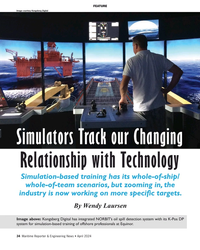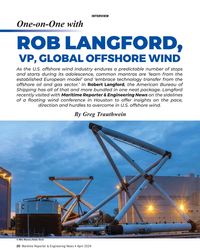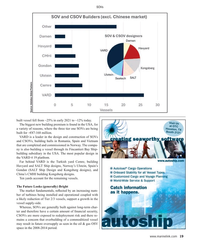Oil And Gas Majors
-
- Advancing Monitoring Requires Advanced Oversight Maritime Reporter, Oct 2013 #44
Recent severe storms in the U.K. North Sea have resulted in a number of floating production, storage and offloading vessels (FPSOs) being shut down in order to assess and repair the damage caused. Notwithstanding the possible safety implications for operations crew, oil and gas majors are facing weeks, if not months without a critical asset which in turn, is having a significant impact on future production.
The design and operation of an FPSO in remote locations requires detailed information on the structural response of the vessel within the local environment offshore. Monitoring of critical components including the risers, hull and mooring lines simultaneously with the local environmental forcing of waves, wind and currents at the site location, provides a valuable insight into the performance and possible extension of the integrity life of the asset. As new technology is introduced, riser design becomes more sophisticated and extension of design life is required. Also, it becomes increasingly important to monitor an asset’s performance to assist with operational decisions, forensic investigation of marine incidents and the evaluation of design codes.
Over the last few years, an increase in the number of offshore incidents related to FPSOs in the North Sea during extreme storm conditions has resulted in focused attention on the verification of design codes and a review of inspection procedures. With an average mooring failure projected at 8.8 years for an FPSO in the North Sea and the consequential damage this could have on the riser, a number of Joint Industry Partnership (JIP) initiatives have concluded that the management and audit of the FPSO integrity is required. Furthermore, indicative costs resulting in the remediation activities required for a single mooring line alone have been estimated at $3.2m for a North Sea FPSO and many companies believe that insurance premiums are likely to rise due to the number of claims now being made.
As an attractive and flexible option which eliminates the need to lay expensive long-distance pipelines, the number of FPSOs being put into service in remote locations is rising. As such, the complexities of understanding the performance of the vessel in given sea-states and the interaction of the FPSO with the subsea infrastructure, becomes imperative.
Marine monitoring systems have primarily been used to provide real-time information for operational support during production with typical examples of its use being: vessel position (particularly in storm conditions); information on the metocean conditions during operation; production riser tension, buoyancy and stroke and mooring line tension for failure detection.
Furthermore, monitoring systems provide information to verify the design of the asset and provide input into fatigue calculations for mooring lines and risers. Currently, finite mathematical modeling is carried out when designing the riser configuration for the FPSO, but what is often lacking is the robust data to validate the actual local environmental conditions. Feeding this data into the design process can help to validate the accuracy of the modeling tools being used and reduce uncertainty.
The standard sensors and parameters that should be measured within the system include:
• Meteorological – the monitoring of the meteorological conditions offshore is critical to ensuring the safe operation of the asset. In 1981, the Civil Aviation Authority (CAA) and the Helideck Certification Agency (HCA) introduced the CAP 437 standard for the U.K. Continental Shelf and currently recommends that meteorological parameters and motion of the helideck are measured for an FPSO. Such parameters provide critical operational information which is sent back to shore so that companies planning any crew changes or helicopter operations are fully aware of the weather status on the vessel before dispatch. Safety of employees is of the upmost importance, therefore companies want to ensure safe take-off and landing conditions
• Wave monitoring – wave induced loads are the main source of fatigue for FPSO design and wave height is a significant factor to consider for the design of the risers, as well as assessment of mooring fatigue life and hull integrity. Recording the extreme events in storm conditions also provides valuable input to the marine forensic investigation of any offshore incident
• Ocean current – Surface currents can impact any offloading operations from the FPSO to the shuttle tankers and influence the response of the risers and moorings, resulting in fatigue loads
• Position and attitude – measurement of the position of the FPSO is essential in storm periods to understand the vessel response to environmental forcing and the coupling of the resultant fatigue on risers and mooring lines. The position of the vessel is also critical in the assessment of any marine incident
• Riser monitoring - a detailed understanding of the environmental forcing to the FPSO combined with the riser response can aid the design process and provide the input to fatigue calculations
• Hull monitoring – stress induced in the deck and hull of an FPSO can be monitored using a series of long base strain gauges positioned in strategic locations on the deck and flare tower. In addition, pressure sensors installed in the hull provide information on the vertical acceleration of the FPSO
• Mooring line – monitoring the mooring line is challenging and there is a scarcity of long term in-situ observed data sets for mooring line tension. For forensic engineering and validation of design codes, it is essential that mooring line tension is collected simultaneously with metocean parameters on a common time base.
Each of the components mentioned above are likely to involve a number of third party suppliers, therefore the challenge that oil and gas majors are faced with is ensuring they all integrate into one effective monitoring system, to provide a holistic approach and support the assets’ integrity management program. Correct placement of the sensors on board the FPSO and full integration of the data within a common time base is vital. By carefully setting up the sensor clocks and sampling frequency during the installation of sensors at strategic locations on the FPSO, companies can use the resultant data set to effectively study the coupled response of the vessel with the environmental and resultant dynamic loading on the risers and mooring lines to study fatigue.
Monitoring of all the different parameters within this common time base can also assist with forensic investigations of marine incidents. For example, companies want to be able to match the time the mooring line broke with the highest wave that hit the FPSO. If the clocks on the mooring sensor are different to that of the wave sensor, forensic engineers will not necessarily marry the two together. Instead of working in isolation, the different parameters must be fully integrated to allow the root cause of the incident to be clearly identified.
Significant advances in technology over the last decade have meant that oil and gas majors can monitor the effect the local environmental conditions have on their critical infrastructure offshore. Sophisticated sensors on board an FPSO can provide real time information for operational support and provide valuable input into studies on the performance of the FPSO in varying sea states. However, to be fully effective, oil and gas companies must look at the monitoring of their critical assets holistically with the end user taking an active role in the planning and implementation of an integrated marine monitoring system. It is vital that data is archived and stored in a common portal to allow engineers and operational teams to make the most of this valuable information.
Only then can they feel confident that the system is indeed fit for purpose and the risks of lost production due to repair or worse, a lengthy shut-down, are minimized.
About the Author
Louise Ledgard has a P hD in Materials Engineering and Design, a Bachelor’s Degree in Applied Physics and a Masters in Business Administration. With over 15 years’ experience working within the offshore oil and gas sector, Louise helps clients to identify an optimum solution for their offshore operational and marine engineering requirements.
(As published in the October 2013 edition of Maritime Reporter & Engineering News - www.marinelink.com)
-
- Offshore Energy: Monitoring Performance Marine Technology, Nov 2013 #42
(FPSOs) being shut down in order to assess and repair the damage caused. Notwithstanding the possible safety implications for operations crew, oil and gas majors are facing weeks, if not months without a critical asset which in turn, is having a significant impact on future production. The design and
-
- Green Marine: Hempel Charts its Growth & Sustainability Course Maritime Reporter, May 2021 #38
gas sector. I think the combination of those two, is something we're going to see much more of in the coming years as well, where the traditional oil and gas majors will also be engaging in offshore activities, renewable activities. So we see North America as a really important opportunity for us in the coming
-
- Voices: NOC Executive Director Ed Hill Marine Technology, Jun 2017 #20
companies who are not so interested in developing the technology but want to shape the way that it evolves and are interested in using it; primarily oil and gas majors and defense companies at the moment. Are there any tangible manifestations of this effort at the National Oceanography Center? Eighteen
-
 )
March 2024 - Marine Technology Reporter page: 42
)
March 2024 - Marine Technology Reporter page: 42versions Image courtesy Kongsberg Discovery are featured in the series, and all withstand reverse pressure, too, and can be installed into both dry and oil-? lled canisters. MacArtney introduced a space and weight-saving ø12.7 mm SubConn Nano, a Nano connector which offers a versatile and robust performance
-
 )
March 2024 - Marine Technology Reporter page: 39
)
March 2024 - Marine Technology Reporter page: 397 A 35Ah AGM lead-acid battery is tested using the West Mountain Radio CBA to show the effect of simply ? lling the battery voids with mineral oil as a compensating ? uid. The CBA is programmed to cut-off at a voltage of 10.50v. The top line (red) shows the unmodi? ed AGM battery capacity of
-
 )
March 2024 - Marine Technology Reporter page: 37
)
March 2024 - Marine Technology Reporter page: 37miscible barrier ? uid heavier than seawater (sg=1.026) and lighter than the battery electrolyte (sg=1.265). The original cell vent cap was screwed into the top of the riser pipe to vent the gases associated with charging. Wires were soldered to the lead (Pb) posts. The lead-acid battery was additionall
-
 )
March 2024 - Marine Technology Reporter page: 36
)
March 2024 - Marine Technology Reporter page: 36, Thus, there are no implodable spaces, and so are candidate and UPS, have speci? c guidelines available on their websites. cells for pressure-balanced, oil-? lled (PBOF) assemblies. This author has personally tested pouch LiPos to 20,000 psi im- Lead-Acid: The venerable lead-acid battery comes in three
-
 )
March 2024 - Marine Technology Reporter page: 35
)
March 2024 - Marine Technology Reporter page: 35.com/BPD.htm). have been tested ? Alkaline (alkaline-manganese dioxide): These prima- ry cells are available in the widest number of standard sizes, in oil-? lled bags and are commonly available around the world. This is handy to pressures of 20,000psi without if you are in a remote port and need
-
 )
March 2024 - Marine Technology Reporter page: 33
)
March 2024 - Marine Technology Reporter page: 33in the world.” How- ever, commercial success depends on many factors, not least a predictable OPEX. Over the past four years, SMD has worked with Oil States Industries to calculate cost per tonne ? gures for prospective customers. Patania II uses jet water pumps to Oil States’ Merlin riser systems
-
 )
March 2024 - Marine Technology Reporter page: 30
)
March 2024 - Marine Technology Reporter page: 30FEATURE SEABED MINING bilical. It has passive heave compensation which nulli? es the necott. “The focus since then has been on scaling while en- wave, current and vessel motions that in? uence loads in the suring the lightest environmental impact,” says The Metals power umbilical. The LARS can
-
 )
March 2024 - Marine Technology Reporter page: 25
)
March 2024 - Marine Technology Reporter page: 25Auerbach explained that ideally, “one ? ed layers of geothermal activity,” noted changes over an area of 8,000 km2. They would have both instruments: seismom- Skett, “and the change in salinity and dis- found up to seven km3 of displaced ma- eters to detect and locate subsurface ac- solved particles for
-
 )
March 2024 - Marine Technology Reporter page: 19
)
March 2024 - Marine Technology Reporter page: 19About the Author vey with the pipe tracker is not required, resulting in signi? - Svenn Magen Wigen is a Cathodic Protection and corrosion control cant cost savings, mainly related to vessel charter. expert having worked across The major advantage of using FiGS on any type of subsea engineering, design
-
 )
April 2024 - Maritime Reporter and Engineering News page: 47
)
April 2024 - Maritime Reporter and Engineering News page: 47.com Powering the fleet for 60 years! HYDRAULIC NOISE, SHOCK AND VIBRATION SUPPRESSOR Noise, Shock, VibraO on & PulsaO on in Quiet, Smooth Flow Out Oil Bladder Nitrogen (blue) Manufactured by MER Equipment Three Stage Noise & PulsaO on in ReducO on Chamber (206) 286-1817 www.merequipment.com QUALITY
-
 )
April 2024 - Maritime Reporter and Engineering News page: 42
)
April 2024 - Maritime Reporter and Engineering News page: 42OPINION: The Final Word Seeing the Ship as a System Shipping must engage with the decarbonization realities that lie ahead by changing the way it crafts maritime legislation to re? ect its place in the interconnected, interdependent world economy, said Eero Lehtovaara, ABB Marine & Ports. ABB Marine &
-
 )
April 2024 - Maritime Reporter and Engineering News page: 41
)
April 2024 - Maritime Reporter and Engineering News page: 41maritime environments: • GMDSS/NAVTEX/NAVDAT coastal surveillance and transmission systems • Offshore NDB non-directional radio beacon systems for oil platform, support vessel & wind farm applications • DGPS coastal differential global positioning systems • VHF port communication systems Nautel
-
 )
April 2024 - Maritime Reporter and Engineering News page: 38
)
April 2024 - Maritime Reporter and Engineering News page: 38, including collecting MARPOL liquid The tanker vessel Archangel, 274 meters long and 85,474 and solid waste, transporting personnel and provisions, and oil gt, was moored using the 3-ton pulling capacity of the moor- spill response services. Images courtesy Consulmar Crowley's New LNG Containerships Carbon
-
 )
April 2024 - Maritime Reporter and Engineering News page: 37
)
April 2024 - Maritime Reporter and Engineering News page: 37SIMULATION "A simulated vessel ? ooding can help teams work together to solve the challenge using different systems on the bridge." – Jussi Siltanen, Lead, "The gami? cation of Product Marketing, learning makes it fun." Safety Solutions at NAPA – Captain Pradeep Chawla, Founder, MarinePALS Image
-
 )
April 2024 - Maritime Reporter and Engineering News page: 35
)
April 2024 - Maritime Reporter and Engineering News page: 35becoming as interconnected as onboard sys- size training materials, including micro-learning videos, gam- tems. Kongsberg Digital has integrated NORBIT’s oil spill ing apps, VR programs and online mentoring. detection system with its K-Pos DP system for simulation- “These digital methods are more effective
-
 )
April 2024 - Maritime Reporter and Engineering News page: 34
)
April 2024 - Maritime Reporter and Engineering News page: 34scenarios, but zooming in, the industry is now working on more speci? c targets. By Wendy Laursen Image above: Kongsberg Digital has integrated NORBIT’s oil spill detection system with its K-Pos DP system for simulation-based training of offshore professionals at Equinor. 34 Maritime Reporter & Engineering
-
 )
April 2024 - Maritime Reporter and Engineering News page: 32
)
April 2024 - Maritime Reporter and Engineering News page: 32? xed wind. The subsidies won’t be a plentiful, and then a second on a luf? ng jib. This reduces the time it would there won’t be the same downturn in oil and gas that made all ordinarily take, weeks, to recon? gure the wiring of an ordi- the high-spec construction vessels available at attractive rates
-
 )
April 2024 - Maritime Reporter and Engineering News page: 28
)
April 2024 - Maritime Reporter and Engineering News page: 28to be placed on a number of our ships to add additional capability. MSC can also lease ship or contract Military Sealift Command’s ? eet replenishment oiler USNS Joshua Humphreys for services as needed. For example, we (T-AO 188) sends fuel to MSC’s fast combat support ship USNS Arctic (T-AOE have
-
 )
April 2024 - Maritime Reporter and Engineering News page: 25
)
April 2024 - Maritime Reporter and Engineering News page: 25vessels can MSC will see up to 20 new ships deliver to carry the equivalent of 30 C-17 transports. the ? eet in the next ? ve years. This includes new oil- Our Combat Logistics Force (CLF) is the key to keep- ing our ships at sea and in the ? ght, and sustain our forces ers, towing, salvage and rescue
-
 )
April 2024 - Maritime Reporter and Engineering News page: 21
)
April 2024 - Maritime Reporter and Engineering News page: 21along with our continued support to the in a UK design ? rm working in the North Sea marine industry,” said Langford. “We continue to hire key in- oil and gas platforms, the holy grail of rigorous dividuals and partner to provide best-in-class solutions.” R conditions in offshore energy production
-
 )
April 2024 - Maritime Reporter and Engineering News page: 20
)
April 2024 - Maritime Reporter and Engineering News page: 20and starts during its adolescence, common mantras are ‘learn from the established European model’ and ‘embrace technology transfer from the offshore oil and gas sector.’ In Robert Langford, the American Bureau of Shipping has all of that and more bundled in one neat package. Langford recently visited
-
 )
April 2024 - Maritime Reporter and Engineering News page: 19
)
April 2024 - Maritime Reporter and Engineering News page: 19more exposed to redeployment risk and there re- mains a concern that overbuilding of a commoditized vessel may result in future oversupply as seen in the oil & gas OSV space in the 2008-2014 period. www.marinelink.com 19 MR #4 (18-33).indd 19 4/5/2024 8:13:37 A
-
 )
April 2024 - Maritime Reporter and Engineering News page: 18
)
April 2024 - Maritime Reporter and Engineering News page: 18through dual fuel near shore Taiwanese market, which is also actively served by engines and (space for) a bunkering system. Currently metha- CTVs. Oil & gas offshore support vessels have been widely nol is a preferred energy carrier although hydrogen and liquid deployed to support construction logistics
-
 )
April 2024 - Maritime Reporter and Engineering News page: 17
)
April 2024 - Maritime Reporter and Engineering News page: 17or under construction in the North Euro- pean wind segment. Tier 2 and Tier 3 walk-to-work (W2W) vessels are cur- rently active in the segment, but as oil www.marinelink.com 17 MR #4 (1-17).indd 17 4/5/2024 8:40:33 A
